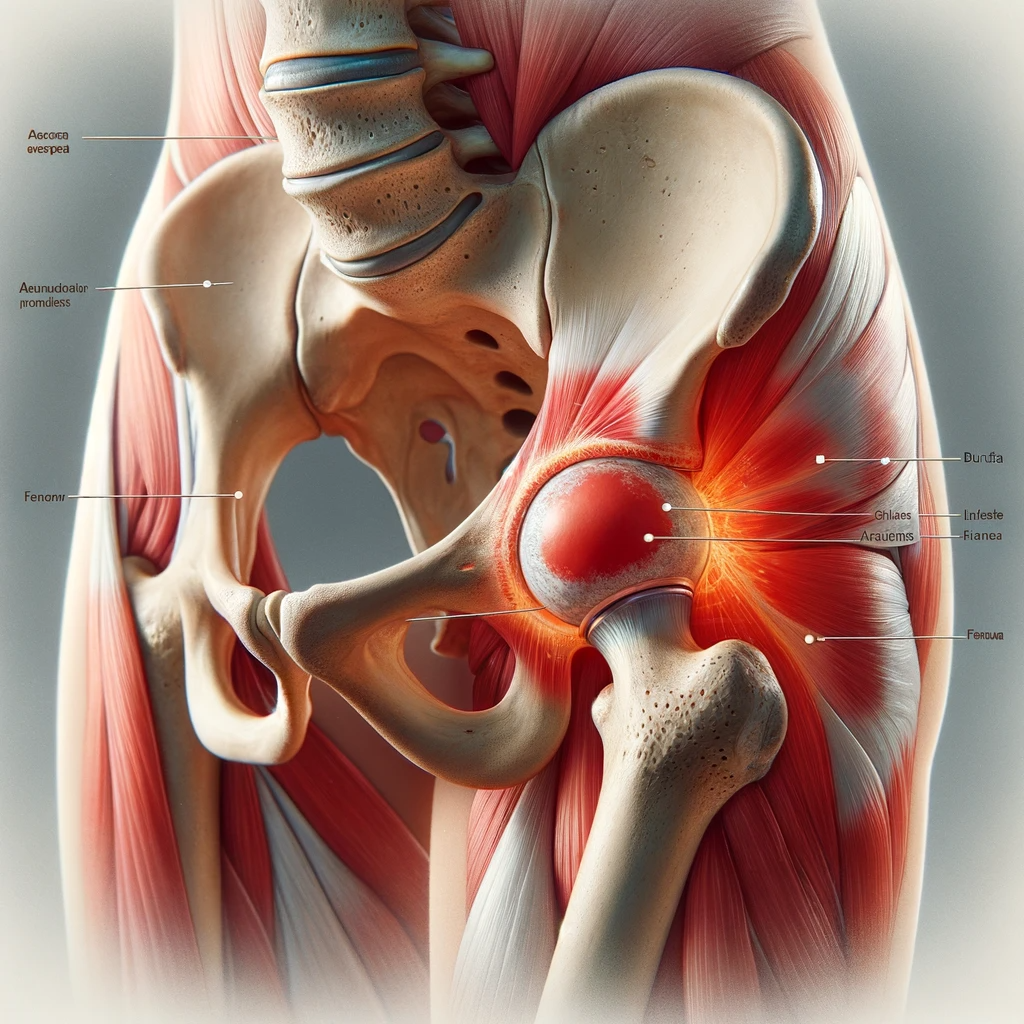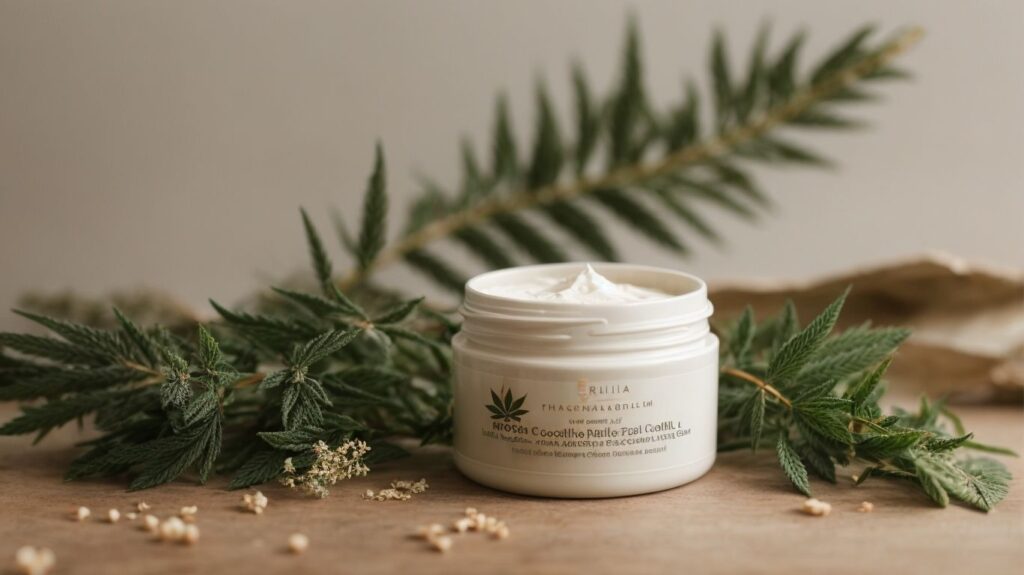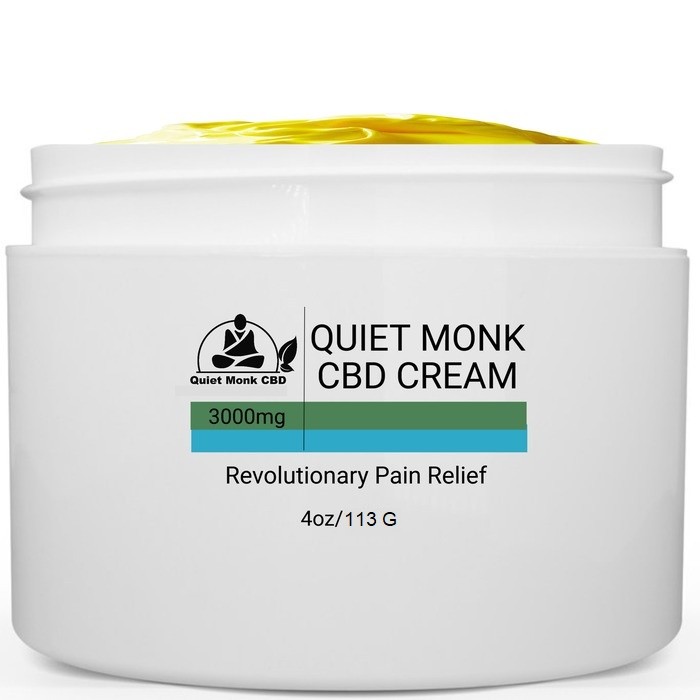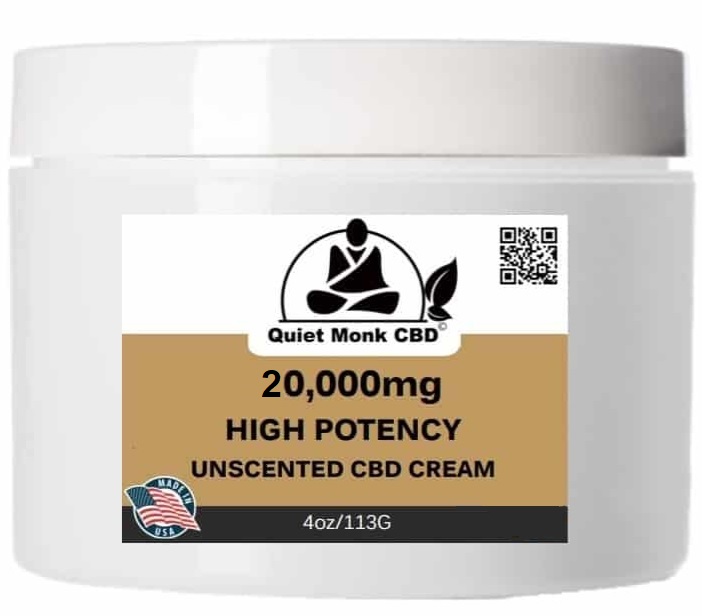Hip bursitis is a condition that involves inflammation of the bursa, a small fluid-filled sac that cushions and reduces friction between bones, tendons, and muscles in the hip joint. It can be caused by repetitive motions, injury, or underlying conditions such as arthritis. The symptoms of hip bursitis can range from mild discomfort to severe pain and can significantly impact daily activities.

Hip bursitis is more common in certain groups of people, such as those who participate in activities that involve repetitive motion of the hip, such as running or cycling, and in individuals with underlying conditions such as rheumatoid arthritis or gout.
Diagnosing hip bursitis involves a physical exam, imaging tests, and possibly a fluid analysis of the bursa. Treatment options for hip bursitis include:
- Rest
- Ice
- Physical therapy
- Medications
- Injections
- Surgery in severe cases
One potential alternative treatment for hip bursitis is the use of CBD cream. CBD, or cannabidiol, is a compound derived from the cannabis plant that has been shown to have anti-inflammatory and pain-relieving properties.
CBD cream is a topical product that can be applied directly to the skin over the affected area. It works by interacting with the body’s endocannabinoid system, which helps to regulate pain and inflammation.
Using CBD cream for hip bursitis may provide some potential benefits, such as reducing pain and inflammation, improving mobility, and promoting relaxation and sleep. It is generally well-tolerated, with minimal side effects.
To use CBD cream for hip bursitis, simply apply a small amount to the affected area and massage it into the skin. It is important to follow the dosage instructions provided by the manufacturer and to consult with a healthcare professional before starting any new treatment.
In addition to CBD cream, there are other natural remedies that may help alleviate symptoms of hip bursitis, such as:
- Turmeric
- Ginger
- Epsom salt baths
- Stretching and strengthening exercises
In conclusion, hip bursitis can be a painful and debilitating condition, but there are various treatment options available, including the use of CBD cream. It is always important to discuss any new treatment with a healthcare professional and to follow their recommendations for managing the condition.
Key Takeaways:
Hip bursitis is a condition that causes inflammation in the bursa, a small fluid-filled sac near the hip joints. Rest, physical therapy, medications, injections, and surgery are common treatment options for hip bursitis. CBD cream may offer potential benefits for managing hip bursitis, such as reducing pain and inflammation, but more research is needed to confirm its effectiveness.
What Is Hip Bursitis?

Hip bursitis is a medical condition that occurs when the bursae, which are small fluid-filled sacs that provide cushioning for the hip joints, become inflamed. This condition is commonly caused by repetitive movements or pressure on the hips. Symptoms of hip bursitis may include pain, swelling, and limited mobility in the hip. Treatment options for hip bursitis include:
- resting
- applying ice
- undergoing physical therapy
- and in some cases, taking medication or receiving injections
It is essential to seek guidance from a healthcare professional in order to receive an accurate diagnosis and appropriate treatment plan for hip bursitis.
What Causes Hip Bursitis?
Hip bursitis is a condition characterized by inflammation of the bursae in the hip joint. It can be caused by repetitive activities, such as running or cycling, that put excessive stress on the hip joint. Other potential causes include hip injuries, infections, and underlying health conditions like rheumatoid arthritis. Additionally, poor posture, muscle imbalances, and tight hip muscles can also contribute to the development of hip bursitis.
By understanding the causes of hip bursitis, individuals can take appropriate preventive measures and seek necessary treatment for this painful condition.
What Are The Symptoms Of Hip Bursitis?
Hip bursitis is a condition where the bursae, small fluid-filled sacs that cushion the hip joints, become inflamed. This can cause various symptoms, including pain, tenderness, swelling, and difficulty walking or climbing stairs. Other signs may also include aching when sitting or lying on the affected side for extended periods of time. Activities involving repetitive hip movements, like running or cycling, may worsen the pain. If you are experiencing these symptoms, it is crucial to seek advice from a healthcare professional for an accurate diagnosis and suitable treatment plan.
Is Hip Bursitis More Common In Certain Groups Of People?
Is Hip Bursitis More Common In Certain Demographics?
Hip bursitis can affect individuals from various demographics, but certain groups may be more prone to developing it. Factors such as age, occupation, and physical activities can contribute to its prevalence.
Athletes, particularly runners and dancers, are at a higher risk due to repetitive hip movements. Middle-aged and older individuals may develop hip bursitis due to age-related wear and tear. Those with occupations that involve prolonged kneeling or squatting, such as plumbers or gardeners, also have an increased likelihood of developing hip bursitis.
Understanding these risk factors can help individuals take preventive measures and seek appropriate treatment if needed.
How Is Hip Bursitis Diagnosed?
Diagnosing hip bursitis involves a combination of medical history, physical examination, and diagnostic tests.
- Medical The doctor will inquire about symptoms, previous injuries, and activities that worsen the pain.
- Physical Examination: The doctor will evaluate the range of motion, palpate the hip joint, and look for signs of inflammation.
- Diagnostic Tests: X-rays can eliminate other possible conditions, while MRI or ultrasound can detect swelling and fluid accumulation in the bursa.
Fact: Hip bursitis is more prevalent in women and individuals over the age of 40.
What Are The Treatment Options For Hip Bursitis?
Suffering from hip bursitis can be a painful and debilitating experience. Thankfully, there are various treatment options available to help alleviate the symptoms and promote healing. In this section, we will discuss the different treatment options for hip bursitis, including rest and ice, physical therapy, medications, injections, and surgery. By understanding these options, you can work with your doctor to determine the best course of treatment for your individual needs.
1. Rest And Ice
Rest and ice are crucial components of the treatment for hip bursitis. Here are the steps to follow:
- Rest: Avoid activities that aggravate the hip bursitis, such as prolonged standing or walking. Give your hip time to heal by limiting your movement and avoiding activities that put stress on the area.
- Ice: Apply an ice pack to the affected area for 15-20 minutes, several times a day. This helps reduce inflammation and provides pain relief.
Resting and icing the hip can significantly alleviate symptoms and promote healing.
2. Physical Therapy
Physical therapy is a highly effective treatment option for individuals with hip bursitis, providing relief from pain and improving overall mobility. Here are the key steps involved in physical therapy for hip bursitis:
- Evaluation: During this stage, a physical therapist will thoroughly assess your condition, including your range of motion, strength, and posture.
- Exercise: Specific exercises will be prescribed to target and strengthen the hip muscles, as well as improve flexibility.
- Manual therapy: Techniques such as massage and joint mobilization may be incorporated to alleviate pain and restore movement.
- Education: Your therapist will educate you on proper body mechanics and strategies to prevent future flare-ups.
Pro-tip: Consistency is crucial! Stick to your physical therapy routine and regularly communicate any concerns or progress with your therapist for optimal results.
3. Medications
When it comes to treating hip bursitis, medications can play a crucial role in managing pain and reducing inflammation. Here are some steps to follow when considering medication options:
- Consult a healthcare professional to determine the severity of your hip bursitis and discuss potential medication options.
- Nonsteroidal anti-inflammatory drugs (NSAIDs) such as ibuprofen or naproxen sodium can be effective in relieving pain and reducing inflammation.
- In some cases, your healthcare professional may prescribe stronger pain medications or corticosteroids to alleviate symptoms.
- Follow the recommended dosage and duration of medication as advised by your healthcare professional.
- Be aware of any potential side effects or interactions with other medications and consult your healthcare professional if you have any concerns.
Remember, medication should be used as part of a comprehensive treatment plan, including rest, physical therapy, and other therapies recommended by your healthcare professional.
4. Injections
When it comes to treating hip bursitis, injections are a commonly recommended option. Here is a step-by-step guide to the injection process:
- Consultation: Visit a healthcare professional who will assess your condition and determine if injections are suitable for you.
- Preparation: The area around the bursa is cleaned and sterilized.
- Anesthesia: Local anesthesia may be administered to numb the area and minimize discomfort during the procedure.
- Injection: A needle is inserted into the bursa, and a corticosteroid medication, such as triamcinolone, is administered to reduce inflammation and pain.
- Post-injection: You may be advised to rest and avoid strenuous activities for a short period after the injection.
Injections have been used as a treatment for various medical conditions for centuries. The ancient Egyptians, for example, used to administer medicinal substances into the body using hollow bird bones. Over time, advancements in medical science have improved the safety and effectiveness of injections, making them a valuable tool in modern medicine.
5. Surgery
Surgery is an option for treating hip bursitis when conservative measures fail to provide relief. The surgical procedure involves removing the inflamed bursa to alleviate pain and inflammation.
Here is a list of steps involved in hip bursitis surgery:
- Consultation: Meet with an orthopedic surgeon to discuss the surgical option.
- Preparation: Complete any necessary pre-operative tests and evaluations.
- Anesthesia: Under general or regional anesthesia, the surgeon makes an incision over the affected bursa.
- Bursa Removal: The surgeon carefully removes the inflamed bursa from the hip joint.
- Closure: After ensuring no bleeding or infection, the incision is closed with stitches or staples.
- Recovery: Follow post-operative instructions for wound care and rehabilitation.
Here’s a true story: John, an avid runner, struggled with hip bursitis for months. Despite trying conservative treatments, the pain persisted. Finally, he opted for surgery. After a successful procedure, he gradually resumed running and was pain-free, getting back to his active lifestyle.
Can CBD Cream Help With Hip Bursitis?
CBD cream has the potential to provide relief for those experiencing hip bursitis. Research indicates that CBD’s anti-inflammatory and analgesic properties may aid in reducing pain and inflammation related to this condition. By applying CBD cream directly to the affected area, individuals may experience relief and promote healing. However, it is important to keep in mind that results may vary depending on the severity of the bursitis and the individual. It is recommended to consult with a healthcare professional to determine the best treatment plan for hip bursitis.
What Is CBD Cream?
CBD cream is a topical product infused with cannabidiol, a compound derived from cannabis plants. It is designed to be applied to the skin for targeted relief. CBD cream is non-intoxicating and does not produce a psychoactive effect like THC. It is commonly used for pain management, reducing inflammation, and soothing skin conditions.
CBD cream works by interacting with the body’s endocannabinoid system, which helps regulate pain, mood, and other bodily functions. If you are wondering “what is CBD cream?” it is a natural and potentially beneficial option for managing hip bursitis. Some potential benefits of using CBD cream for this condition include pain relief, reduced inflammation, and improved mobility. However, as with any treatment, individual experiences may vary. It is always recommended to consult with a healthcare professional before trying CBD cream or any new treatment.
How Does CBD Cream Work?
CBD cream works by interacting with the body’s endocannabinoid system (ECS) and targeting specific receptors to provide relief for hip bursitis. The following steps explain how CBD cream works:
- Application: Apply a small amount of CBD cream directly to the affected area.
- Absorption: The cream is absorbed through the skin and into the underlying tissues.
- Interaction: CBD interacts with the ECS receptors in the skin, muscles, and joints.
- Anti-inflammatory properties: CBD reduces inflammation and swelling, alleviating pain.
- Analgesic effects: CBD acts as a natural pain reliever by blocking pain signals.
Pro-tip: For optimal results, use CBD cream regularly and combine it with other holistic approaches like stretching exercises and rest.
What Are The Potential Benefits Of Using CBD Cream For Hip Bursitis?
Using CBD cream for hip bursitis can potentially provide various benefits due to its anti-inflammatory and analgesic properties. This cream can effectively reduce pain and inflammation in the hip, resulting in relief and improved mobility. Furthermore, CBD cream may also aid in promoting relaxation and reducing muscle tension in the affected area.
It is important to keep in mind that CBD cream should be used as a complementary treatment and not as a replacement for medical advice or prescribed medications. It is highly recommended to consult with a healthcare professional to determine the most suitable treatment plan for hip bursitis.
Are There Any Side Effects Of Using CBD Cream?
When using CBD cream for hip bursitis, it’s important to be aware of potential side effects. While CBD is generally well-tolerated, there may be some mild side effects, such as dryness or irritation at the application site, redness, or a rash. Although rare, it is also possible to experience an allergic reaction.
As with any topical product, it’s crucial to perform a patch test before widespread use to check for any adverse reactions. If any persistent or severe side effects occur, it is best to discontinue use and seek advice from a healthcare professional.
How To Use CBD Cream For Hip Bursitis?
Using CBD cream for hip bursitis can be an effective way to alleviate pain and inflammation. Here are the steps to properly use CBD cream for hip bursitis:
- Clean and dry the affected area before applying the cream.
- Take a small amount of CBD cream and gently massage it into the hip joint, focusing on the bursa area.
- Apply the cream 2-3 times a day or as directed by a healthcare professional.
- Allow the cream to fully absorb into the skin before covering the area with clothing or bandages.
- Continue using the CBD cream regularly until the symptoms of hip bursitis improve.
True story: Jane, an avid runner, struggled with hip bursitis pain. She decided to try CBD cream after researching its benefits. Jane followed the steps above and gradually noticed a reduction in her pain and inflammation. With consistent use, CBD cream became an essential part of her hip bursitis management routine, allowing her to continue enjoying her passion for running.
Are There Any Other Natural Remedies For Hip Bursitis?
Along with using CBD cream, there are other natural remedies that can help alleviate the symptoms of hip bursitis. These include turmeric, ginger, Epsom salt, and specific stretching and strengthening exercises. Let’s take a closer look at each of these options and how they can aid in the treatment of hip bursitis. By incorporating these natural remedies into your routine, you may find even more relief from this common condition.
1. Turmeric
Turmeric is a natural remedy that can potentially help with hip bursitis. Incorporating this powerful spice into your routine may alleviate inflammation and pain associated with this condition.
- Include turmeric in your diet by adding it to dishes, such as curry or smoothies.
- Consider taking turmeric supplements, following the recommended dosage.
- Apply a turmeric paste topically to the affected area by mixing turmeric powder with water or coconut oil.
- For enhanced absorption and effectiveness, combine turmeric with black pepper.
- Before starting any new supplement or treatment, it is always best to consult with a healthcare professional.
2. Ginger
Ginger is a natural remedy that can potentially alleviate the symptoms of hip bursitis. This powerful ingredient contains anti-inflammatory properties that can effectively reduce pain and swelling in the affected area. Whether consumed in its fresh root form, as ginger tea, or through supplements, ginger can provide relief for hip bursitis. Additionally, ginger essential oil or ginger paste can be applied topically for potential relief. However, it is always important to consult with a healthcare professional before incorporating ginger or any other natural remedies into your treatment plan for hip bursitis.
3. Epsom Salt
Epsom salt can be utilized as a natural remedy to alleviate symptoms of hip bursitis. Here are the steps to utilize Epsom salt for relief:
- Dissolve 2 cups of Epsom salt in warm bathwater.
- Soak the affected hip in the Epsom salt bath for 15-20 minutes.
- Repeat this process 2-3 times a week to reduce pain and inflammation.
- Ensure the Epsom salt bath is warm, not hot, to avoid further irritation.
- Consult with a healthcare professional before using Epsom salt as a treatment option.
4. Stretching And Strengthening Exercises
To help alleviate symptoms of hip bursitis and promote recovery, it can be beneficial to incorporate stretching and strengthening exercises into your routine. Here are some exercises to consider:
- Quadriceps stretch: Stand and hold onto a support, bend one knee, and bring your heel towards your buttocks while keeping your thighs aligned.
- Hamstring stretch: Sit on the edge of a chair with your legs extended, lean forward, and reach towards your toes while keeping your back straight.
- Glute bridge: Lie on your back with your knees bent, lift your hips off the ground, and squeeze your glutes.
- Side-lying leg lift: Lie on your side, with your legs extended, lift the top leg towards the ceiling, and lower it back down.
Remember to consult with a healthcare professional before starting any exercise regimen.



